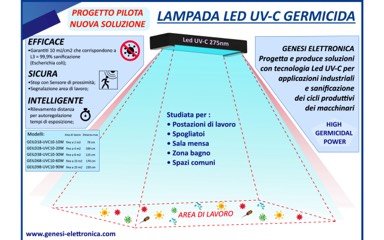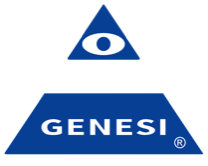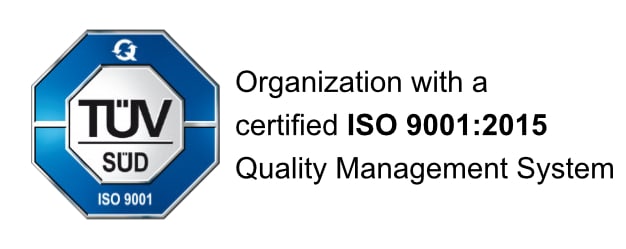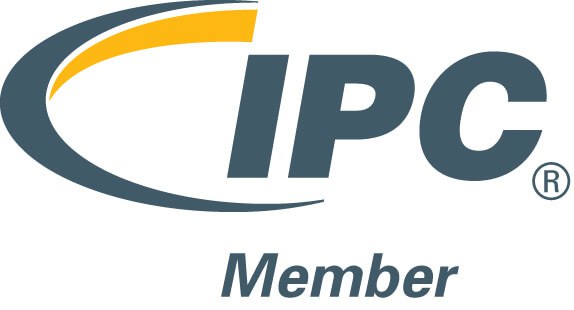Innovative solutions for UV-C disinfection in the industrial sector
Innovative solutions for UV-C disinfection in the industrial sector
In the last past years, and especially in recent months, with the advent of the Covid-19, the demand for sanitization of the workplaces and internal machinery has increased enormously because of the need to clean surfaces or products during the production cycle.
Together with these needs we have seen the development of several solutions aimed at solving necessities such as:
Thorough cleaning of surfaces with the aid of steam, alcohol or chlorine-based substances.
This kind of cleaning is considered the “main rule” to keep the level of germs and bacteria low, however, it is often hardly applicable in technical environments.
Disinfection with sodium hypochlorite gas, hydrogen peroxide or ozone.
This is an ideal solution for periodically sanitizing large volumes and some production machineries applications, even if the potentially toxic gas management has its own application problems.
Disinfection with UV-C neon source, germicidal lamps (254 nm)
This solution is used with good results in many applications, including portable ones or with robots help which irradiate surfaces or liquids with one or more neon lights. However, it is short-lived, it has a low application flexibility and other problems due to mains voltage supply.
Disinfection with UV-A LED source (365-385 nm) + photocatalysis
This is a sanitization process based on the reaction of titanium dioxide (TiO2) which, irradiated with UV-A light, produces short-lived oxidizing compounds (nanoparticles) that break down the microbial load in air and water. This process takes advantage from the high performance of the UV-A LEDs (up to 60%) as the low cost of the LED and the Titanium Dioxide. Unfortunately, being a combined solution, it has some application limits.
Disinfection with UV-C germicidal LED source (275 nm)
LEDs with sufficient wavelengths and powers became available a few months ago, in fact, producers such as Seoul, Liteon, Vishay and Luminus Devices put on the market types of LEDs for the disinfection sector.
This new UVC LED generation has an actual performance of 2%, but in the future months other types with higher performance will be available.
In the last past years, and especially in recent months, with the advent of the Covid-19, the demand for sanitization of the workplaces and internal machinery has increased enormously because of the need to clean surfaces or products during the production cycle.
Together with these needs we have seen the development of several solutions aimed at solving necessities such as:
Thorough cleaning of surfaces with the aid of steam, alcohol or chlorine-based substances.
This kind of cleaning is considered the “main rule” to keep the level of germs and bacteria low, however, it is often hardly applicable in technical environments.
Disinfection with sodium hypochlorite gas, hydrogen peroxide or ozone.
This is an ideal solution for periodically sanitizing large volumes and some production machineries applications, even if the potentially toxic gas management has its own application problems.
Disinfection with UV-C neon source, germicidal lamps (254 nm)
This solution is used with good results in many applications, including portable ones or with robots help which irradiate surfaces or liquids with one or more neon lights. However, it is short-lived, it has a low application flexibility and other problems due to mains voltage supply.
Disinfection with UV-A LED source (365-385 nm) + photocatalysis
This is a sanitization process based on the reaction of titanium dioxide (TiO2) which, irradiated with UV-A light, produces short-lived oxidizing compounds (nanoparticles) that break down the microbial load in air and water. This process takes advantage from the high performance of the UV-A LEDs (up to 60%) as the low cost of the LED and the Titanium Dioxide. Unfortunately, being a combined solution, it has some application limits.
Disinfection with UV-C germicidal LED source (275 nm)
LEDs with sufficient wavelengths and powers became available a few months ago, in fact, producers such as Seoul, Liteon, Vishay and Luminus Devices put on the market types of LEDs for the disinfection sector.
This new UVC LED generation has an actual performance of 2%, but in the future months other types with higher performance will be available.
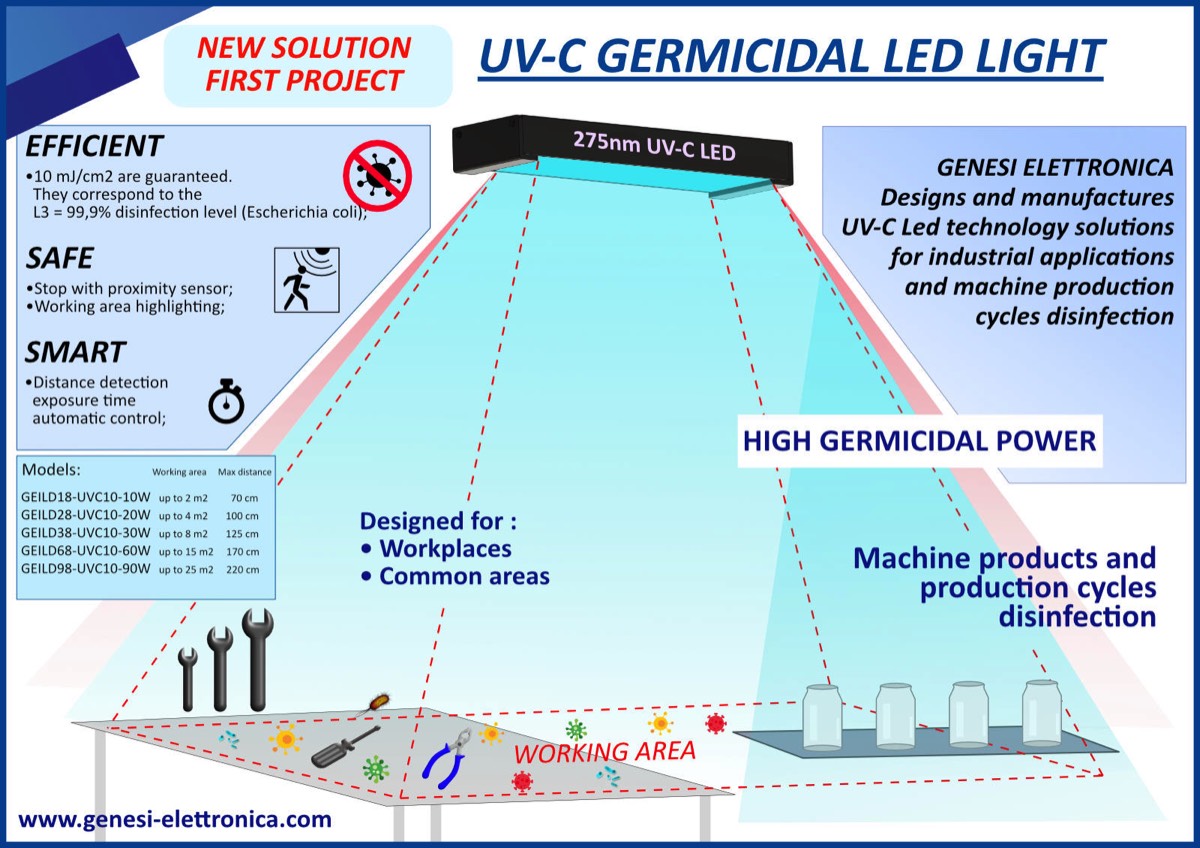
In these years Genesi Elettronica has been developing and producing over 300 kind of led lights for the industrial automation sector. Genesi has understood that this new UV-C led technology is interesting to develop solutions for the machine and plant manufacturers. For this reason its designers have started a new project to show how it is easy to implement this technical solution, beginning from:
Safe UV-C led lamp
The danger of this wavelength is known, the light emitted by these LEDs is not visible with the naked eye except some light blue traces (carcinogenic risk also at short-term exposure), for this reason the lamp is provided with a proximity sensor that interrupts the emission in case of motion with the aid of an integrated sensor. Furthermore the irradiated area is specularly highlighted by a flashing red light that indicates where the lamp is sanitizing.
Safe UV-C led lamp
The danger of this wavelength is known, the light emitted by these LEDs is not visible with the naked eye except some light blue traces (carcinogenic risk also at short-term exposure), for this reason the lamp is provided with a proximity sensor that interrupts the emission in case of motion with the aid of an integrated sensor. Furthermore the irradiated area is specularly highlighted by a flashing red light that indicates where the lamp is sanitizing.
Efficient disinfection at 99,9%
The availability of adjustable light power, internal temperature and distance calculation from the surface with the flight sensor, the microprocessor can calculate the exposure time to reach the right dose of power for the set up disinfection level.
The availability of adjustable light power, internal temperature and distance calculation from the surface with the flight sensor, the microprocessor can calculate the exposure time to reach the right dose of power for the set up disinfection level.
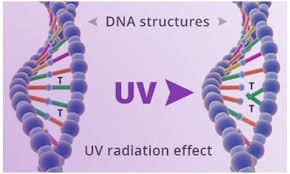
For the first versions of the lamp we programmed the L3 level, that corresponds with the 99,9% of the germ and bacteria reduction taking as a reference the escherichia coli bacteria (reference standard). The needed quantity to reach this target is 10 mJ/cm2.
Smart UV-C lamp
How can the lamp do all these things in a safe way ensuring the disinfection?
Monitoring the environmental parameters through the microprocessor, it can control the quantity of power and the emission time.
The disinfection cycle starts when one of these 3 events occurs:
The disinfection cycle stops when:
The integrated status led indicates these combinations:
The start button, if pressed for a short time, allows the cycle to start but if the button is pressed for more than 2 seconds the red leds turn on to indicate the area that will be irradiated by the UV-C rays.
The motion, temperature and flight time sensors (that calculates the distance from the working area) are continuously monitored by the programmed microprocessor.
How can the lamp do all these things in a safe way ensuring the disinfection?
Monitoring the environmental parameters through the microprocessor, it can control the quantity of power and the emission time.
The disinfection cycle starts when one of these 3 events occurs:
- After 10 minutes from the motion detection
- After 5 seconds from the pressing of the start button
- After 4 hours from the end of the last disinfection cycle.
The disinfection cycle stops when:
- At the end of the calculated time on the basis of the distance from the surface and of the emitted UVC radiation quantity, when the quantity of power for the set up level is reached the exposure time can change from 2 to 90 minutes. This is inversely proportional to the distance and shorter if the chosen model is more powerful.
- The motion sensor is on, in this case the cycle starts again if the interruption lasts up to 5 minutes, otherwise another cycle begins.
- The power supply (24 Vdc) is interrupted, when it is on again no data storage is kept and the cycle starts from the beginning.
The integrated status led indicates these combinations:
- Orange; turned on waiting to do a cycle
- Flashing red; within 10 seconds a disinfection cycle starts (during the disinfection cycle the powerful red leds flash over all the radiated area)
- Green; a disinfection cycle has been done from less than 4 hours.
The start button, if pressed for a short time, allows the cycle to start but if the button is pressed for more than 2 seconds the red leds turn on to indicate the area that will be irradiated by the UV-C rays.
The motion, temperature and flight time sensors (that calculates the distance from the working area) are continuously monitored by the programmed microprocessor.
Table with models that are being developed:
Model | Length | Working area | Maximum distance | Working area power for every cycle |
GEILD18-UVC10-10W | 18 cm | Fino a 2 m2 | 70 cm | 10 mJ/cm2 |
GEILD28-UVC10-20W | 28 cm | Fino a 4 m2 | 100 cm | 10 mJ/cm2 |
GEILD38-UVC10-30W | 38 cm | Fino a 8 m2 | 125 cm | 10 mJ/cm2 |
GEILD68-UVC10-60W | 68 cm | Fino a 15 m2 | 170 cm | 10 mJ/cm2 |
GEILD98-UVC10-90W | 98 cm | Fino a 25 m2 | 220 cm | 10 mJ/cm2 |

.png)
